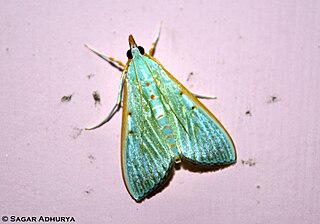
Glyphodes is a genus of moths of the family Crambidae described by Achille Guenée in 1854.

Diaphania indica, the cucumber moth or cotton caterpillar, is a widespread but mainly Old World moth species. It belongs to the grass moth family, and therein to the large subfamily Spilomelinae. This moth occurs in many tropical and subtropical regions outside the Americas, though it is native to southern Asia; it is occasionally a significant pest of cucurbits and some other plants.

Glyphodes negatalis, the karanj defoliator, is a moth of the family Crambidae. The species was first described by Francis Walker in 1859. It has a wide range in the tropics, including South Africa, The Gambia, Mali, India, Sri Lanka, Hong Kong, Japan and eastern Australia.

Glyphodes sibillalis, the mulberry leaftier moth, is a moth of the family Crambidae. It is found in the southern United States, Central and South America and the West Indies.

Arthroschista hilaralis, also known as the kadam defoliator, is a moth in the family Crambidae. It was described by Francis Walker in 1859. It is found in India, Sri Lanka, Burma, Cambodia, Sumatra, Borneo and in Australia, where it has been recorded from Queensland.
Glyphodes actorionalis is a moth in the family Crambidae. It was described by Francis Walker in 1859. It is found in Zambia, India and Indonesia.

Glyphodes caesalis is a moth in the family Crambidae. It was described by Francis Walker in 1859. It is found in Sri Lanka, mainland India, Myanmar, the Andaman Islands, New Guinea, Bangladesh, Fiji, Hong Kong, Thailand and Australia (Queensland).

Glyphodes pyloalis, the lesser mulberry snout moth, lesser mulberry pyralid or beautiful glyphodes moth, is a moth in the family Crambidae. It was described by Francis Walker in 1859. It is found in Iran, China, Japan, India, Indonesia (Sumatra), Sri Lanka, Taiwan, the Democratic Republic of the Congo, Equatorial Guinea, Mozambique and North America, where it has been recorded from Florida, Maryland, North Carolina, South Carolina and Virginia.
Glyphodes conjunctalis is a moth in the family Crambidae. It was described by Francis Walker in 1866. It is found on the Sula Islands, Misool, New Guinea, Seram, Ambon Island and Australia (Queensland).
Glyphodes badialis is a moth in the family Crambidae. It was described by Francis Walker in 1859. It is found on Borneo.

Glyphodes crithealis is a moth in the family Crambidae. It was described by Francis Walker in 1859. It is found in China.
Glyphodes dinichealis is a moth in the family Crambidae. It was described by Francis Walker in 1859. It is found in Rio de Janeiro, Brazil.
Glyphodes eribotesalis is a moth in the family Crambidae. It was described by Francis Walker in 1859. It is found in Brazil.
Glyphodes phytonalis is a moth in the family Crambidae. It was described by Francis Walker in 1859. It is found on Borneo.








